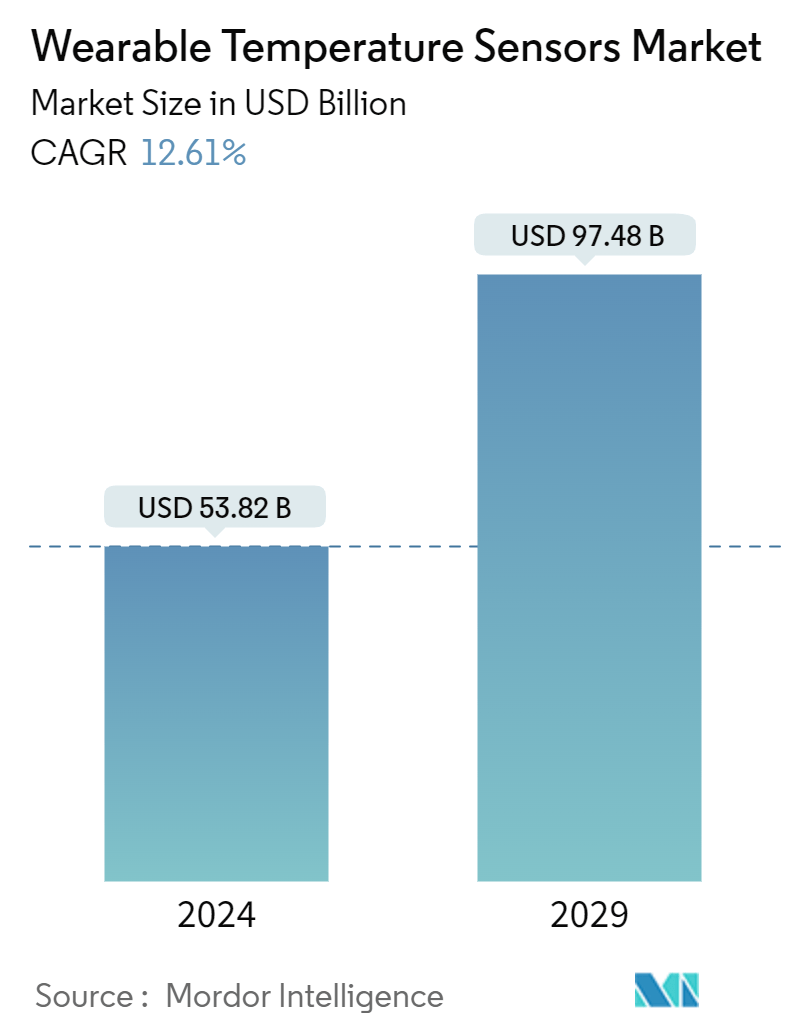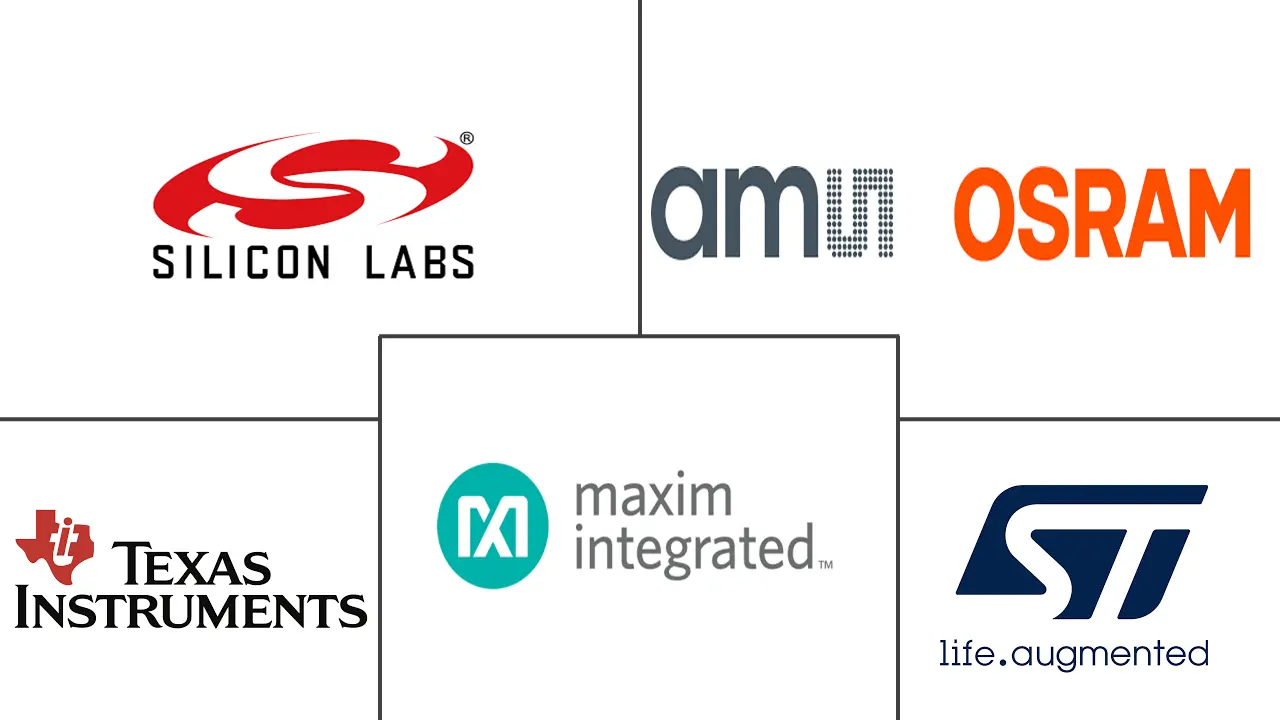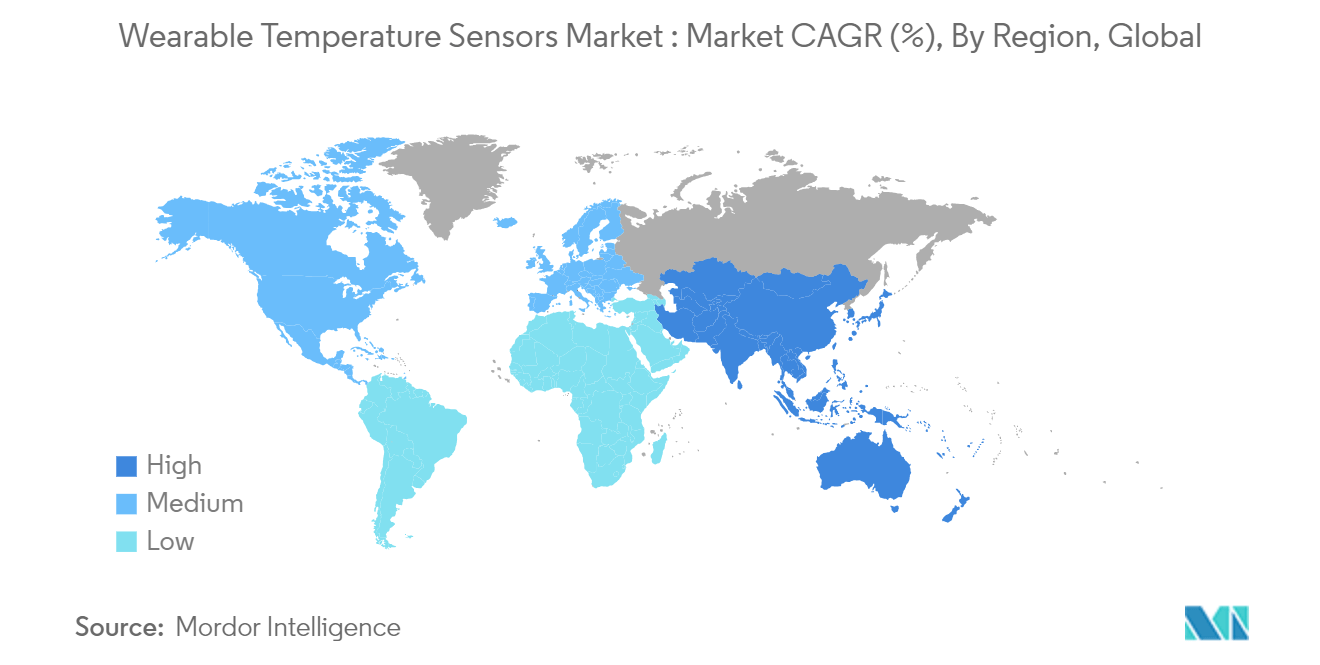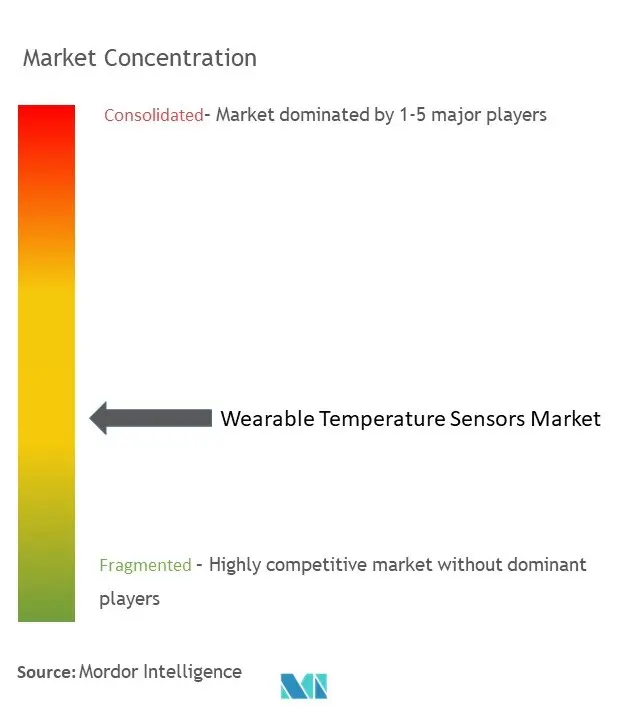Wearable Temperature Sensors Market Size

| Study Period | 2019 - 2029 |
| Market Size (2024) | USD 53.82 Billion |
| Market Size (2029) | USD 97.48 Billion |
| CAGR (2024 - 2029) | 12.61 % |
| Fastest Growing Market | Asia Pacific |
| Largest Market | North America |
Major Players
*Disclaimer: Major Players sorted in no particular order |
Wearable Temperature Sensors Market Analysis
The Wearable Temperature Sensors Market size is estimated at USD 53.82 billion in 2024, and is expected to reach USD 97.48 billion by 2029, growing at a CAGR of 12.61% during the forecast period (2024-2029).
Wearable temperature sensors are portable sensors that are used independently to measure human temperature. These sensors are directly integrated into wearable devices or the human body to monitor heart rate, body temperature, and pulse rate. Wearable sensors have gained popularity in the healthcare and diagnosis industry, where several parameters are of vital importance, namely blood pressure, heart rate, and body temperature.
- Spending on consumer electronic products is also stimulating the growth of wearable devices. The increasing urbanization and changing lifestyle of the growing population have increased health and safety awareness. This is a major factor stimulating the growth of wearable devices, such as fitness trackers, earwear, and smartwatches.
- The rapidly increasing trend of smart living and the growing number of connected devices are expected to enhance the wearable temperature sensors market. These wearable temperature sensors increase awareness regarding fitness and health in people of all age groups, driving the growth of wearable sensors.
- Also, wearable sensor devices have emerged as a significant part of the sports industry since they help athletes stick to their daily routines and provide important information about the parameters they are programmed to monitor. Moreover, the advent of advanced wearable devices that comprise smaller, smarter, and low-cost sensors, together with the growing adoption of AI and IoT, is further projected to ensure the growth of the wearable devices market, which is anticipated to create a positive impact on the wearable temperature sensors market.
- With the growing propensity of consumers toward smart wearables, the prices of devices are also soaring along with the growing cost of components, which limits adoption in the market. Smartwatches and fitness trackers have low-cost segments that drive significant attention from consumers. However, with the proliferation of technology, other devices such as footwear, eyewear, and body wear products are highly priced and have lower adoption rates.
Wearable Temperature Sensors Market Trends
Healthcare is Expected to Register the Fastest Growth Among All End-user Verticals
- Wearable temperature sensors are significantly used in the healthcare sector to monitor body temperature in real time. Examples include fever detection, continuous monitoring of patients, and tracking temperature variations for individuals with certain medical conditions.
- They enable the continuous monitoring of an individual's body temperature, aiding in the early detection of abnormal variations. This real-time data is crucial for timely intervention, especially in infections or chronic conditions. Wearable sensors also provide a non-invasive and convenient way to track health parameters, enhancing patient comfort and compliance with monitoring protocols.
- These sensors are emerging as a new technology for remote health monitoring to detect physiological and biochemical markers by estimating vital signs such as respiratory rate, blood oxygen level, and body temperature; wearable temperature sensors offer immense potential for the non-invasive and early diagnosis of multiple diseases, including COVID-19.
- The growing geriatric population and the increasing number of advantages of wearable devices in healthcare are projected to accelerate the expansion of the market during the forecast period. According to the Population Reference Bureau, about 25% of the population is under 15 years of age, and 10% is over 65 years of age.

Asia-Pacific is Expected to Register Significant Growth
- The major share of the Asia-Pacific region can be attributed to the growth in application areas of the healthcare sector. The escalating demand in the emerging economies of China, South Korea, and India is expected to greatly contribute to the regional demand for such wearable temperature sensors.
- The Asia-Pacific region is expected to witness significant growth during the forecast period. Major factors supporting growth are increasing investments in medical infrastructure, research and innovation centers, government programs, and policies favoring the healthcare equipment and devices markets.
- The Asia-Pacific region is anticipated to experience market share growth due to the increasing prevalence of chronic disorders and the rising awareness of medical sensors among individuals. The growth of the wearable temperature sensors market in these regions is attributed to the increased emphasis on the development of medical sensors in recent years, the enhancement of healthcare infrastructure, and the early detection of diseases.
- Given the region's aging population, there is always room for innovation in the field of medical devices and equipment, which provides opportunities for foreign companies to invest in the country. For instance, in July 2023, Boat announced the release of its smart ring with health and fitness tracking features. The ring has various health sensors, such as measuring the user's body temperature, heart rate tracking, sleep monitoring, female menstrual cycle mapping, etc.

Wearable Temperature Sensors Industry Overview
The wearable temperature sensors market is semi-consolidated. Some of the global key players in this market are Silicon Laboratories Inc., Maxim Integrated Products Inc., STMicroelectronics NV, Texas Instruments Inc., and AMS-OSRAM AG. These firms have been continuously expanding their operations by focusing on market expansions and acquisitions, product launches, and technological upgrades.
- February 2024: GreenTEG's collaboration with WITHINGS is expected to revolutionize health monitoring. The partnership involves integrating GreenTEG's cutting-edge CALERA sensor, designed for core body temperature monitoring, into the latest WITHINGS Scanwatch NOVA.
- February 2024: Sensirion, a leading sensor manufacturer, revealed plans to expand its production facility in Debrecen, Hungary, by an additional 5,000 sq. m. The expansion is set to be executed in two phases, with the first phase slated for completion in Q4 2024 and the second phase expected to be wrapped up by Q1 2025. This move is poised to bolster Sensirion's production capabilities, particularly in the realm of sensor modules.
Wearable Temperature Sensors Market Leaders
-
Silicon Laboratories Inc.
-
Maxim Integrated Products Inc.
-
STMicroelectronics NV
-
Texas Instruments Inc.
-
AMS-OSRAM AG
*Disclaimer: Major Players sorted in no particular order

Wearable Temperature Sensors Market News
- February 2024: GreenTEG was selected as the preferred partner by AMS OSRAM; together, they are expected to spearhead the development of cutting-edge wearable technology focused on consumer health. This collaboration aims to introduce an enhanced health matrix primarily focused on tracking core body temperature. By leveraging GreenTEG's CALERA technology, the joint effort resulted in a holistic reference design. This design encompasses the integration of various components, including the gSKIN XU heat flux sensor, AMS OSRAM's AS6221 skin temperature sensor, and a core temperature algorithm powered by machine learning.
- February 2024: Researchers from the University of Washington unveiled a pioneering wearable technology product: the "Thermal Earring." This wireless smart earring, outperforming smartwatches in detecting skin temperature during rest, showcased its potential in a study involving six individuals. The researchers also highlighted its ability to monitor signs of stress, eating, exercise, and ovulation.
Wearable Temperature Sensors Market Report - Table of Contents
1. INTRODUCTION
- 1.1 Study Assumptions and Market Definition
- 1.2 Scope of the Study
2. RESEARCH METHODOLOGY
3. EXECUTIVE SUMMARY
4. MARKET INSIGHTS
- 4.1 Market Overview
-
4.2 Industry Attractiveness - Porter's Five Forces Analysis
- 4.2.1 Bargaining Power of Suppliers
- 4.2.2 Bargaining Power of Buyers
- 4.2.3 Threat of New Entrants
- 4.2.4 Threat of Substitutes
- 4.2.5 Intensity of Competitive Rivalry
- 4.3 Industry Value Chain/Supply Chain Analysis
- 4.4 Assessment of the Impact of Macroeconomic Factors and COVID-19 on the Market
5. MARKET DYNAMICS
-
5.1 Market Drivers
- 5.1.1 Increasing Health Awareness Among all Age Groups
- 5.1.2 Technological Advancement in Wearable Devices
-
5.2 Market Challenges
- 5.2.1 High Product Cost
6. MARKET SEGMENTATION
-
6.1 By Application
- 6.1.1 Body Wear
- 6.1.2 Eye Wear
- 6.1.3 Foot Wear
- 6.1.4 Wrist Wear
- 6.1.5 Other Applications
-
6.2 By End-user Vertical
- 6.2.1 Healthcare
- 6.2.2 Sports/Fitness
- 6.2.3 Industrial
- 6.2.4 Other End-user Verticals
-
6.3 By Geography***
- 6.3.1 North America
- 6.3.2 Europe
- 6.3.3 Asia
- 6.3.4 Australia and New Zealand
- 6.3.5 Latin America
- 6.3.6 Middle East and Africa
7. COMPETITIVE LANDSCAPE
-
7.1 Company Profiles*
- 7.1.1 Silicon Laboratories Inc.
- 7.1.2 Maxim Integrated Products Inc.
- 7.1.3 STMicroelectronics NV
- 7.1.4 Texas Instruments Inc.
- 7.1.5 AMS-OSRAM AG
- 7.1.6 Melexis
- 7.1.7 Analog Devices Inc.
- 7.1.8 GreenTEG
- 7.1.9 TE Cnnectivity Ltd
- 7.1.10 Sensirion AG
8. INVESTMENT ANALYSIS
9. FUTURE OF THE MARKET
** Subject To AvailablityWearable Temperature Sensors Industry Segmentation
Wearable temperature sensors are portable sensors that are used independently to measure human temperature. These sensors are directly integrated into wearable devices or the human body to monitor heart rate, body temperature, and pulse rate. Wearable sensors have gained popularity in the healthcare and diagnosis industry, where several parameters are of vital importance, namely blood pressure, heart rate, and body temperature.
The wearable temperature sensors market is segmented by application (body wear, eyewear, footwear, wrist wear, and other applications), end-user vertical (healthcare, sports/fitness, industrial, and other end-user verticals), and geography (North America, Europe, Asia-Pacific, and the Rest of the World). The market sizes and forecasts are provided in terms of value (USD) for all the above segments.
| By Application | Body Wear |
| Eye Wear | |
| Foot Wear | |
| Wrist Wear | |
| Other Applications | |
| By End-user Vertical | Healthcare |
| Sports/Fitness | |
| Industrial | |
| Other End-user Verticals | |
| By Geography*** | North America |
| Europe | |
| Asia | |
| Australia and New Zealand | |
| Latin America | |
| Middle East and Africa |
Wearable Temperature Sensors Market Research FAQs
How big is the Wearable Temperature Sensors Market?
The Wearable Temperature Sensors Market size is expected to reach USD 53.82 billion in 2024 and grow at a CAGR of 12.61% to reach USD 97.48 billion by 2029.
What is the current Wearable Temperature Sensors Market size?
In 2024, the Wearable Temperature Sensors Market size is expected to reach USD 53.82 billion.
Who are the key players in Wearable Temperature Sensors Market?
Silicon Laboratories Inc., Maxim Integrated Products Inc., STMicroelectronics NV, Texas Instruments Inc. and AMS-OSRAM AG are the major companies operating in the Wearable Temperature Sensors Market.
Which is the fastest growing region in Wearable Temperature Sensors Market?
Asia Pacific is estimated to grow at the highest CAGR over the forecast period (2024-2029).
Which region has the biggest share in Wearable Temperature Sensors Market?
In 2024, the North America accounts for the largest market share in Wearable Temperature Sensors Market.
What years does this Wearable Temperature Sensors Market cover, and what was the market size in 2023?
In 2023, the Wearable Temperature Sensors Market size was estimated at USD 47.03 billion. The report covers the Wearable Temperature Sensors Market historical market size for years: 2019, 2020, 2021, 2022 and 2023. The report also forecasts the Wearable Temperature Sensors Market size for years: 2024, 2025, 2026, 2027, 2028 and 2029.
Wearable Temperature Sensors Industry Report
Statistics for the 2024 Wearable Temperature Sensors market share, size and revenue growth rate, created by Mordor Intelligence™ Industry Reports. Wearable Temperature Sensors analysis includes a market forecast outlook to 2029 and historical overview. Get a sample of this industry analysis as a free report PDF download.



